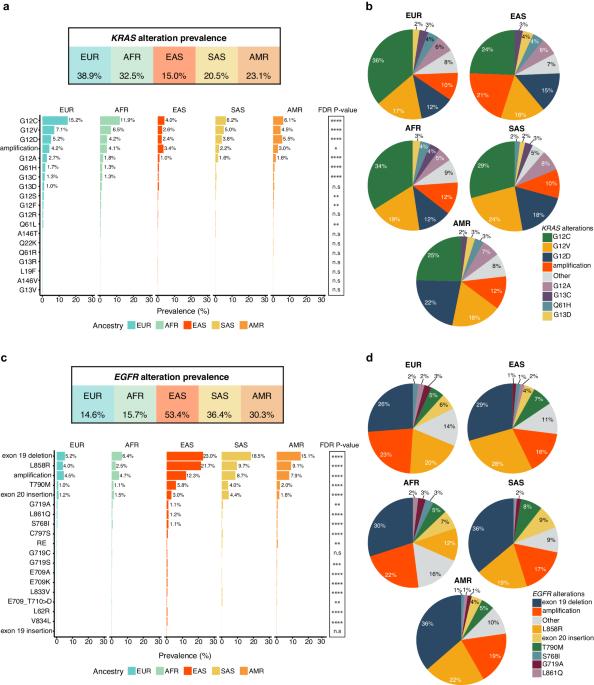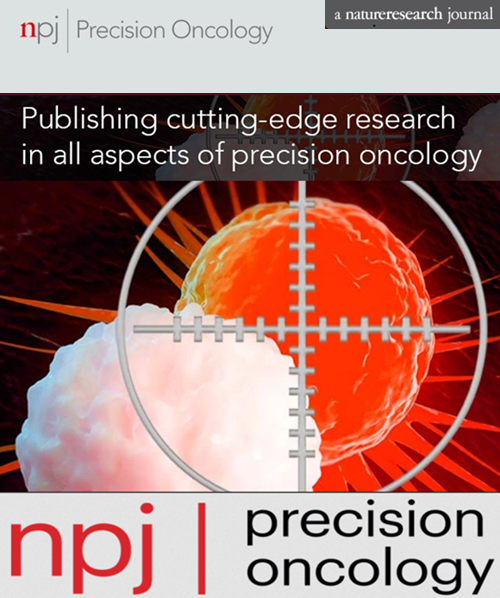Ancestry-associated co-alteration landscape of KRAS and EGFR-altered non-squamous NSCLC
IF 6.8
1区 医学
Q1 ONCOLOGY
引用次数: 0
Abstract
Racial/ethnic disparities mar NSCLC care and treatment outcomes. While socioeconomic factors and access to healthcare are important drivers of NSCLC disparities, a deeper understanding of genetic ancestry-associated genomic landscapes can better inform the biology and the treatment actionability for these tumors. We present a comprehensive ancestry-based prevalence and co-alteration landscape of genomic alterations and immunotherapy-associated biomarkers in patients with KRAS and EGFR-altered non-squamous (non-Sq) NSCLC. KRAS was the most frequently altered oncogene in European (EUR) and African (AFR), while EGFR alterations predominated in East Asian (EAS), South Asian (SAS), and Admixed American (AMR) groups, consistent with prior studies. As expected, STK11 and KEAP1 alterations co-occurred with KRAS alterations while showing mutual exclusivity with EGFR alterations. EAS and AMR KRAS-altered non-Sq NSCLC showed lower rates of co-occurring STK11 and KEAP1 alterations relative to other ancestry groups. Ancestry-specific co-alterations included the co-occurrence of KRAS and GNAS alterations in AMR, KRAS, and ARID1A alterations in SAS, and the mutual exclusivity of KRAS and NF1 alterations in the EUR and AFR ancestries. Contrastingly, EGFR-altered tumors exhibited a more conserved co-alteration landscape across ancestries. AFR exhibited the highest tumor mutational burden, with potential therapeutic implications for these tumors.

KRAS和表皮生长因子受体(EGFR)改变的非鳞状 NSCLC 的祖先相关共变图谱。
种族/族裔差异会影响 NSCLC 的护理和治疗效果。虽然社会经济因素和获得医疗保健的机会是造成 NSCLC 差异的重要原因,但深入了解与遗传祖先相关的基因组图谱可以更好地了解这些肿瘤的生物学特性和治疗可操作性。我们介绍了 KRAS 和表皮生长因子受体(EGFR)改变的非鳞状(非 Sq)NSCLC 患者的基因组改变和免疫疗法相关生物标记物的基于祖先的全面流行和共同改变情况。KRAS是欧洲人(EUR)和非洲人(AFR)中最常发生改变的癌基因,而EGFR改变则主要发生在东亚人(EAS)、南亚人(SAS)和美国混血人(AMR)群体中,这与之前的研究结果一致。不出所料,STK11 和 KEAP1 基因改变与 KRAS 基因改变同时存在,而与 EGFR 基因改变则互斥。与其他血统组相比,EAS和AMR KRAS改变的非Sq NSCLC共存STK11和KEAP1改变的比例较低。血统特异性共变包括:AMR血统中KRAS和GNAS共变;SAS血统中KRAS和ARID1A共变;EUR血统和AFR血统中KRAS和NF1共变。相反,表皮生长因子受体(EGFR)改变的肿瘤在不同血统中表现出更为一致的共同改变特征。非洲裔的肿瘤突变负荷最高,对这些肿瘤具有潜在的治疗意义。
本文章由计算机程序翻译,如有差异,请以英文原文为准。
求助全文
约1分钟内获得全文
求助全文
来源期刊

NPJ Precision Oncology
ONCOLOGY-
CiteScore
9.90
自引率
1.30%
发文量
87
审稿时长
18 weeks
期刊介绍:
Online-only and open access, npj Precision Oncology is an international, peer-reviewed journal dedicated to showcasing cutting-edge scientific research in all facets of precision oncology, spanning from fundamental science to translational applications and clinical medicine.
文献相关原料
| 公司名称 | 产品信息 | 采购帮参考价格 |
|---|
 求助内容:
求助内容: 应助结果提醒方式:
应助结果提醒方式:


